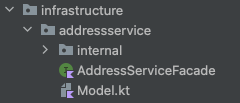From complexity to simplicity: How to write integrations with external services
Integration with external services, regardless of their type, is the backbone of modern microservices architecture. The era of huge monolithic applications with a single database is over. Today, implementing even a small business process requires cooperation with other services.
In this article, I’d like to share with you an approach to designing such an integration. It’s a simple set of guidelines that helps you create a clear, well-structured, and reliable design — an approach used by some teams at Allegro.
Introduction #
Before I reveal the final solution, I want to explain what frustrated me in the approach I tried before. For a very long time my default approach to writing integration with external services was applying Hexagonal Architecture. While Hexagonal Architecture looks great on paper, applying it in real-world projects can be challenging, especially without prior experience. If you’re new to the topic, all these concepts and recommendations can be hard to grasp. In my opinion, writing code should be easy. If you need to spend hours explaining all these concepts to a new developer, and then spend even more time during code reviews fixing misalignments with Hexagonal Architecture, something is not right.
The high entry barrier to Hexagonal Architecture isn’t the only thing that has started to bother me over time. Other aspects that have also raised my concerns are the recommended naming conventions for ports and the way code is organized regarding integration with external services. Below, I’ll elaborate on these topics in more detail.
Problems with Hexagonal Architecture #
One of the first issues I noticed with Hexagonal Architecture is that port names are often too generic. Alistair Cockburn, the author of Hexagonal Architecture, recommends that a port’s name should reflect “communication intent” behind it — the reason why the domain interacts with the outside world. To make this intent clear, a port’s name should typically include a verb.
Examples:
| Description | Name |
|---|---|
| This port is for getting order fees | GetOrderFees |
| This port is for getting order’s IDs | GetOrderIds |
| This port is for publishing product description | PublishProductDescription |
| This port is for notifying subscribers | NotifySubscribers |
The problem with highlighting “communication intent” and using a verb-based convention is that it works well only for single-method ports. If we want to include more than one method in a port, this approach stops working, and developers must shift toward noun-based conventions with suffixes like Provider, Notifier, Fetcher, and so on.
Ports that use either verb-based or noun-based naming conventions are in my opinion often too general — they lack the precision needed in more complex systems. When reading the code, it’s not always obvious which external services are involved in a given business process. In large-scale systems like Allegro — where the same type of data can come from different services — knowing the exact data source is extremely helpful, both for understanding the system and for maintaining it.
Imagine you get an alert that some endpoint in your service is responding slower than expected and is breaking SLA. What do you do?
If the problem is not related to time spent in garbage collection or thread pool utilization, it is likely related to the response times
from external services or the database. In such cases, it is crucial to quickly understand which external systems are involved in executing the given
business process in order to confirm this hypothesis. If the names of the ports used for communication with
external services have very generic names like GetProduct, this kind of analysis is harder, especially at 3 a.m.
In large microservice environments, teams often manage 10+ services. It’s impossible to remember the details of all of them — especially if you joined recently, or haven’t touched a given service in a while. That’s why it helps to include the name of the external system in the port name — it makes debugging and support much easier.
Secondly, method names in these interfaces often mirror the interface name itself when using verb-based convention.
For instance, in a port GetProduct, you might find a method like getProduct(...) or getProductFor(...).
When you also consider the fact that reference names for these ports are often auto-generated by the IDE, you can easily end up with code like:
val getProduct: GetProduct
getProduct.getProductFor(...)
Unfortunately, it doesn’t read well.
Another problem I see with Hexagonal Architecture is port placement. Ports are defined by the domain layer to decouple business logic from the infrastructure layer (external services). It’s the domain that declares the port contracts — which means all interfaces describing ports, along with any supporting classes they require, should reside in the domain layer.
In many projects I’ve seen in the past, more than 50% of the domain layer consisted of port definitions and their supporting classes. In such designs, it was hard to tell what the domain was actually doing because it was cluttered with many small classes. Sometimes it even turned out that the domain wasn’t doing anything at all — serving merely as a placeholder for port definitions and their dependencies. Ports in the domain also created confusion about where to find them, as each project had its own take on what “in the domain” really meant.
With all these concerns about Hexagonal Architecture in mind, let’s discuss a solution that addresses them quite well.
Adding Service Context to Port Names #
The original idea of expressing “communication intent” is valid — but in my experience, it works better in the method name, not the interface name. For the interface itself, I recommend the naming pattern <ServiceName>Facade.
Example:
interface ProductDescriptionFacade {
fun getProductDescription(productId: ProductId): ProductDescriptionDto
}
val productDescriptionFacade: ProductDescriptionFacade
val productDescription = productDescriptionFacade.getProductDescription(productId)
This makes it immediately clear which external system is being used. The interface can be implemented by an HTTP client or adapter — that’s why the name Facade fits well. Not every method in the facade has to be a direct mapping to an external API call. Sometimes, the adapter performs additional processing or aggregation before returning the result — and that’s perfectly fine.
When applying the <ServiceName>Facade convention, remember that we are not designing interfaces around a specific service! Using the service name in a port is meant only to make the code easier to read — not to drive the design of our application. The choice of integration style between two services should always be preceded by deliberate analysis. Sometimes the external model is good enough that there’s no need to map it to something else, and we can simply bring it into our service — conformist style. Other times, maximum separation is required — in that case, we create our own model and isolate ourselves as much as possible from external dependencies — Anti-Corruption Layer (ACL).
Moving Ports Out of the Domain Layer #
Another change is moving ports, along with the supporting classes that define their contract out of the domain layer to infrastructure layer. The infrastructure layer, which contains all information about integrations with external services, is divided into a domain part and a technical implementation part (internal). Below is an example package structure for integration with AddressService.

Each integration with an external system consists of three things:
- Port: an interface used by the domain layer, named using the pattern <ServiceName>Facade, e.g. AddressServiceFacade.
- model.kt file: This file contains all data classes used in the port’s method signatures. These classes are shared with the domain and define the port’s contract.
- internal package: This package contains the actual implementation of the port (e.g. an HTTP client), along with any mapping or deserialization logic, spring configuration. Everything here is considered internal and should not be used outside.
Keep in mind that all classes inside the internal package must remain unused outside of that package. The following architectural test ensures that no class from the internal package is used outside of it. This enforces a clear boundary between the public and private parts of each integration. At the domain level, the only elements that can be accessed from the infrastructure package are the facade interfaces (*Facade.kt) and classes defined in model.kt file. This layout clearly separates API used by the domain (ports) from internal implementation details, making the codebase easier to navigate and maintain.
@ParameterizedTest
@MethodSource("internalPackages")
fun `access to internal infrastructure classes is restricted to their own package`(
internalPackage: String,
importedClasses: JavaClasses
) {
val rule = noClasses()
.that().resideOutsideOfPackage("$internalPackage..")
.should().dependOnClassesThat().resideInAnyPackage("$internalPackage..")
rule.check(importedClasses)
}
...
companion object {
@JvmStatic
fun internalPackages(): Stream<Arguments> {
val importedClasses = ClassFileImporter()
.withImportOption(ImportOption.DoNotIncludeTests())
.importPackagesOf(AppRunner::class.java)
return importedClasses.map { it.packageName }
.filter { it.endsWith("internal") }
.distinct()
.map { Arguments.of(it, importedClasses) }
.stream()
}
}
Why move Port and model.kt outside the domain package? By following this convention, it becomes much easier to find all the interfaces that describe integrations with external services. It also keeps the domain package lightweight and dedicated to the core elements that support the application layer, like domain services, factories, and other domain-specific components.
Embrace the Change #
What happens if at some point we switch integration from service X to service Y? What impact will it have?
In such a case, the only thing we need to do is rename the interface and package to match the new implementation. This change has zero impact on the business logic. The thing that matters most to the domain — the interface contract — stays exactly the same. Ports are defined by the domain’s requirements, with the only difference being that they are physically placed in the infrastructure package, which in turn is divided into a domain part, containing the port definition and the model, and an internal part that describes the details of the current implementation, hidden from other packages.
The entire complexity of the change is isolated within the internal package, keeping the rest of the application unaffected. No changes in the internal package will affect business logic.
Summary #
To conclude, I’d like to emphasize that architecture should be flexible and adapted to the specific needs of your project, your team, and other relevant factors. The presented set of guidelines helps you design integrations with external services that are simple to implement, easy to change, and maintainable in the long run.
Credits #
The presented solution is inspired by the excellent talk “Modularity and Hexagonal Architecture in Real Life” by Jakub Nabradlik. The idea of using an internal package and ArchUnit, instead of relying on package scope to protect the details of each integration, comes from the team I work with.
